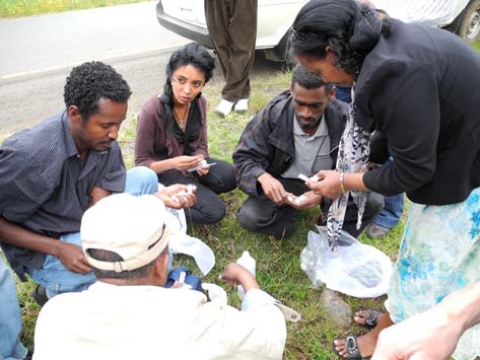 BOEVE, Jean-Luc (RBINS) & PAULY, Alain (RBINS)
BOEVE, Jean-Luc (RBINS) & PAULY, Alain (RBINS)
Entomological fauna of Ethiopia with emphasis on bee pollinators and other Hymenoptera (2010-2012)
Promoted by: Dr Jean-Luc Boevé (RBINS) & Dr. A. Pauly (RBINS)
Local partners
Principal partner is the Zoological Natural History Museum (ZNHM) in Addis Ababa (Director Dr S. Mengistou), but students/staff of the Biology Department of the University of Addis Ababa, the Holetta Bee Research Center and the Oromia Agricultural Research Institute in Macahara (Western Harare) are also involved. Partnership will alo be set up with the Institute of Biodiversity Conservation in Addis Ababa which delivers the needed exploration permits for non-commercial biodiversity research.
Identified taxonomic impediments
Biotopes and biodiversity are as much unique as endangered in Ethiopia. But conservation measures are difficult to establish for insects, which remain underrepresented in Ethiopian national collections. Consequently, a good collection-based knowledge about current insect diversity in the field, but also about the biology and ecology of most Ethiopian species is largely missing. This is especially true for the Hymenoptera, which include (highly beneficial) bees as well as sawflies (which can be pests). Improved taxonomic data are an absolute prerequisite to get to a better understanding of their present status in threatened habitats, and for pest management.
Objectives
Objectives of the first year of the project were to:
- Establish institutional contacts to determine the specific institutional needs in terms of know-how and knowledge related to local hymenopteran fauna. A privileged partnership with the ZNHM was foreseen.
- Establish an insect collection framework, by training one or a few Ethiopian scientist(s)
The long-term objective (second year of project and possibly beyond) is to establish a stable basis for non-commercial research on Ethiopian bee and sawfly taxonomy and biodiversity and this by collecting and documenting the target taxa in different Ethiopian biotopes and conservation areas.
Poverty reduction components
Pollination is an essential feature for both biodiversity conservation and agriculture, and many plants including crops rely for their reproduction on pollinators such as bees. Ethiopia (besides Mexico and China) is a major producer of beeswax and it is the world’s tenth biggest honey producer. Further, biodiversity conservation can lead to the discovery of specialized natural enemies of pest insects, by which such antagonists (e.g. parasitoids) can be integrated in pest control programs. It is therefore a crucial deal for a country to take stock of its natural insect resources by conserving a high biodiversity level, which in turn can improve agricultural productivity, and consequently, ensure a better human food supply.
The present projects will help Ethiopia in developing a scientific approach to entomology in its applications to biodiversity conservation and agriculture. As pointed out by Loader et al. [Loader S, Mengistu A, Schwaller S, Gower D, Nagel P, Getahun A, Saber S & Kassahun R (2009) Are Ethiopian highlands changing? Amphibians as ecosystem indicators. Mountain Forum Bull., 9:5-6.]: “Mountain ecosystems have recently received considerable interest based on the understanding that climate change might have particularly serious irreversible impacts on physical and biological systems in these habitats. … For Africa, few quantitative studies exist whereby conclusions can be firmly established, and this means that a fresh focus on the region is required”. These statements are appealing when considering the present project that is devoted to the Ethiopian entomofauna, a fauna for sure adversely affected in the highlands by global climatic change. But, it will be doubtful to predict any significant contribution of the project to the current debate on global change, simply because this would have required an adequate reference collection of insects managed since at least several decades ago. In other words, it seems impossible to judge the impact, hitherto, of global change on the Ethiopian entomofauna. In contrast, the present project devoted to bees and sawflies may help, as one among other indicators, to establish such an impact in the future. These considerations are also strengthening the timeliness of the project.
Scientific capacity building
Overall, build-up of know-how and knowledge on bee and sawfly taxonomy and collection management.
Expected output
Besides multi-authored scientific publications, another important output will be a freely available PDF-document where all wild bee species, collected in Ethiopia during the two GTI projects, will be illustrated and accompanied by other datasets (for instance with information on the host plants). Possibly, a dedicated and informative website that liberates the gathered results will also be set up.
Check out some of the training material used by Boevé & Pauly here.
Information on the taxonomy of the bees of subsaharan Africa as well as keys to the subsaharan bee subgenera are available in the seventh (English) and ninth (French) volume of the series Abc Taxa
Get a pictorial impression of this project below.




Top left: students in Holeta Bee Research Center; top right: mission statement of the Holeta Bee Research Center; Bottom left: Xylocopa specimens; Bottom right: Nomiinae specimens

